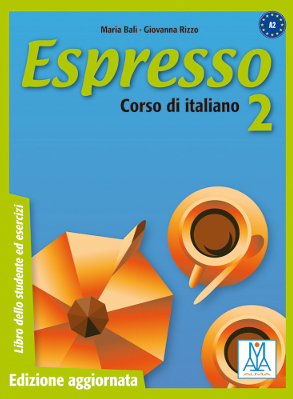Espresso 2 is the second of a three-book series of the same title aimed at students who want to learn Italian as a second language. The book addresses A2/Pre-Intermediate learners, according to the Common European Framework of Reference for Languages (CEFR), who already have a basic knowledge of Italian. The text is divided into 10 units with lessons and exercises, an appendix, 10 final chapters with further exercises on the topic of each unit, a grammar reference section (with the explanation of the rules seen in each unit), two glossaries (one organized by unit and another alphabetically), exercises keys and bibliographic references.
Book Overview
All ten units are similarly organized into sections of vocabulary and grammar exercises, short written compositions, reading and listening comprehensions. The themes in each unit cover common cultural aspects, such as the family (La famiglia), childhood (Da piccola…), travelling (Buon viaggio), jobs (il mondo del lavoro) and so on. However, these are dealt with quite stereotypically without taking into consideration, for example in the vocabulary section, how Italian society has changed in the last twenty years, and therefore they do not introduce contemporary, updated terms regarding family, jobs, etc., such as terms that refer to multicultural families or in the job section. For example, very little space is devoted to technology, emails, internet and so on. In this sense, it would be useful for teachers or self-taught students to provide extra, more up-to-date vocabulary and contexts.
"Overall, the book is a good tool for a lower intermediate level and can be used both in courses and as self-learning material. However, teachers and people interested in learning something about contemporary Italian culture need to be prepare to look for some extra material to integrate more up to date contexts and vocabulary."
Furthermore, in the vocabulary and grammar sections, exercises like matching or fill in the gaps are followed by cartoon images and drawings, which, although offering a light take on the theme, give a somewhat childish and unrealistic tone to the book. In this sense it would have been better to use a larger number of real photos and maps. In general, the number of activities per theme is well balanced, especially if you consider the dedicated exercise sections at the end of the book that offer extra material to practice with.
A puzzling deficiency is the lack of the dialogue transcripts at the end of the book. Most of the dialogues in each unit have comprehension exercises that can involve fill-in-the-gap type of activities, comprehension questions or both. Whereas most of these have a complete transcription within the unit (thing that can actually be counterproductive, since students may try to read the dialogues instead of making the effort of listening to the audio), some of them don’t. Therefore students, especially self-taught students, do not have the possibility to check their comprehension abilities or simply expand their vocabulary.
A final comment has to be made about the (few) songs chosen as listening activities in the book. Songs are generally a very pleasant way to get an idea of idiomatic expressions as well as cultural trends. Having said that, it seems very odd that the only two songs included in the book are quite dated and do not really offer a glance into contemporary Italian pop-culture or trends. A positive adding is “Facciamo il Punto”, a section that after two or three units includes a situational game, a short text with comprehension questions, and an auto-evaluation chart. In the game students need to create sentences and short dialogues using the expressions and vocabulary repertoire learnt in the previous units. However, being the structure of the game is always the same all throughout the book, it can become a bit boring. The second part of this section is called “Caffé Culturale”, an interesting page with short texts from newspaper or book excerpts that offers a glance into Italian culture and contemporary issues (e.g. football, unemployment, etc.)
Finally, there is an auto-evaluation page (Bilancio) to auto check which abilities the students have developed and which need improvement. At the end of the units there is a useful appendix with extra resources to further deepen the themes from the book. These can be used as extra activities in class or as review/exam materials. The Grammar Reference offers a good and clear summary of the rules with reference to the lesson in which this rule is seen in context. However, it could have been even more productive if few exercises were offered at the end of each rule to reinforce it.

A plus of the book is a chart comparing the activities of the book with the abilities required by the CEFR for a A2 level. In this way, teacher can use the material to prepare students for a formal exam and self-taught students can use this as a reference. Overall, the book is a good tool for a lower intermediate level and can be used both in courses and as self-learning material. However, teachers and people interested in learning something about contemporary Italian culture need to be prepare to look for some extra material to integrate more up to date contexts and vocabulary. As already mentioned, the repertoire and vocabulary are a little outdated and seem to refer to social and cultural contexts of few decades ago and therefore do not always coincide with current situations




